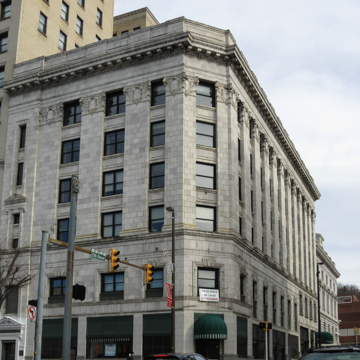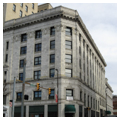You are here
Laconia Building
Washington Hall, a public meeting room designed in the Gothic Revival style, was built on this downtown corner in 1851–1853. In May and June 1861, opening sessions of the first and second Wheeling Conventions, which were instrumental in the eventual creation of West Virginia, were held in the hall. For a brief period
Architect Frederic F. Faris emphasized the angled corner entrance, but otherwise completely altered the building into one of Wheeling's most accomplished and individualistic classical essays. He treated the first two floors architecturally as a single vertical unit, terminating them with an entablature that acts as a belt course for the four stories above. The bays of the upper stories are divided by rudimentary pilasters with rococo, Corinthian-esque capitals that support a heavy entablature and solid, paneled balustrade.
According to the caption to a drawing that Ohio Architect published in its November 1915 issue, the banking room was decorated by Tiffany Studios of New York. The bank's once impressive corner entrance and banking room have been remodeled, and the first floor now houses a restaurant.
Writing Credits
If SAH Archipedia has been useful to you, please consider supporting it.
SAH Archipedia tells the story of the United States through its buildings, landscapes, and cities. This freely available resource empowers the public with authoritative knowledge that deepens their understanding and appreciation of the built environment. But the Society of Architectural Historians, which created SAH Archipedia with University of Virginia Press, needs your support to maintain the high-caliber research, writing, photography, cartography, editing, design, and programming that make SAH Archipedia a trusted online resource available to all who value the history of place, heritage tourism, and learning.




